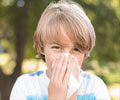The prevalence of childhood allergies has increased over the past decade in many countries of the world, especially among younger age groups.
An Article published in the August 26 issue of "The Lancet" has revealed that the prevalence of childhood allergies has increased over the past decade in many countries of the world, especially among younger age groups.
Innes Asher from University of Auckland, New Zealand, and colleagues repeated the International Study of Asthma and Allergies in Childhood (ISAAC) between 2002-2003 to assess the global prevalence of asthma, hayfever, and eczema. The study was done previously in 1991 to assess the worldwide prevalence of asthma, hayfever, and eczema.A total of 193,400 children from 37 countries aged 6-7 years were included in the study and the parents of these children were questioned about the symptoms of asthma and allergy such as wheezing in their child. The same questions were put across to another 304, 680 children aged 13-14 years from 56 countries including Sweden, South Africa, Brazil, Canada, Iran, UK, and New Zealand.
The researchers found that increase in prevalence of allergies was more common than decreases, especially among younger age group. They found that eczema was more prevalent among younger age groups, while hayfever was prevalent in both the age groups. However, there was decrease in prevalence of asthma in older age group.
The researchers noted that Asia-Pacific and India were the only regions where increase in prevalence of all three disorders was noted in both the age groups.
Factors like air pollution, diet, lifestyle, and exposure to bacteria in early life were linked to the rise in asthma and other allergies.
The lead author of the study, Professor Asher concludes that "the data have direct relevance for health-service delivery in the countries included in the study as well as providing a basis for understanding these disorders. In almost all centers, there was a change in prevalence of one or more disorders over time. Although changes in mean annual prevalence to the order of 0.5% might sound small, such changes could have substantial pubic-health implications, especially since the increases took place most commonly in heavily populated countries."
Advertisement
Source-Medindia
SAR






